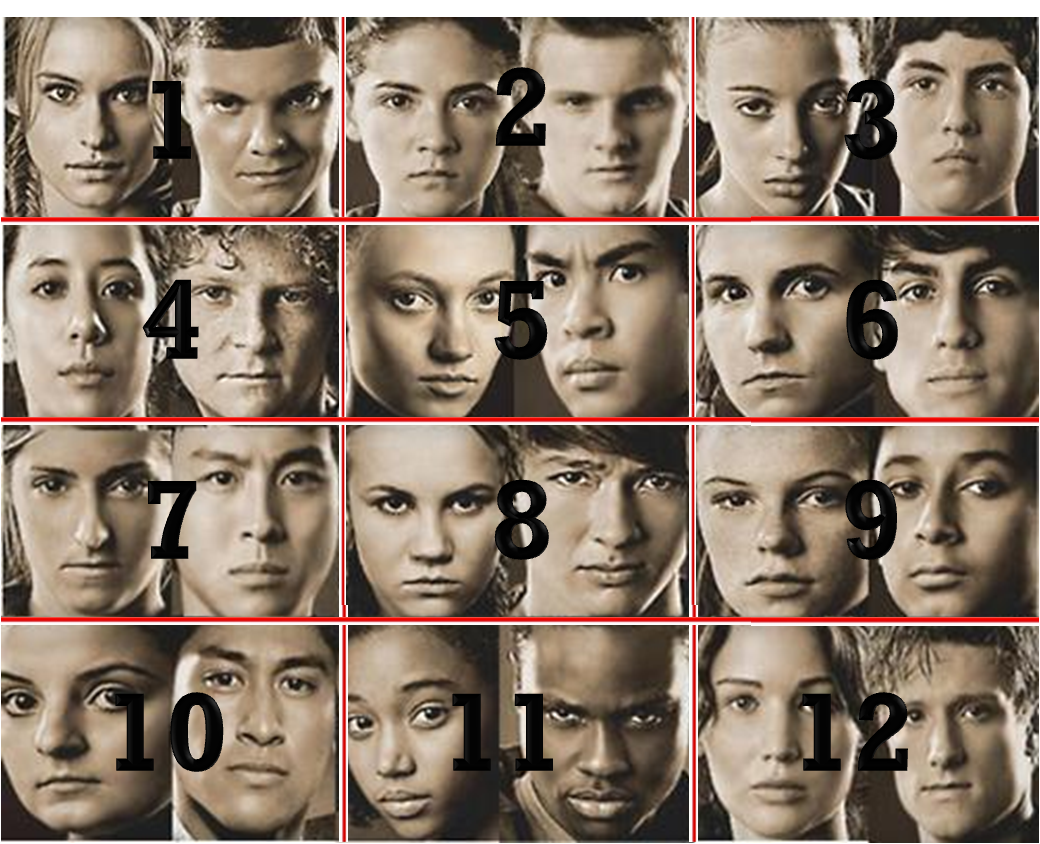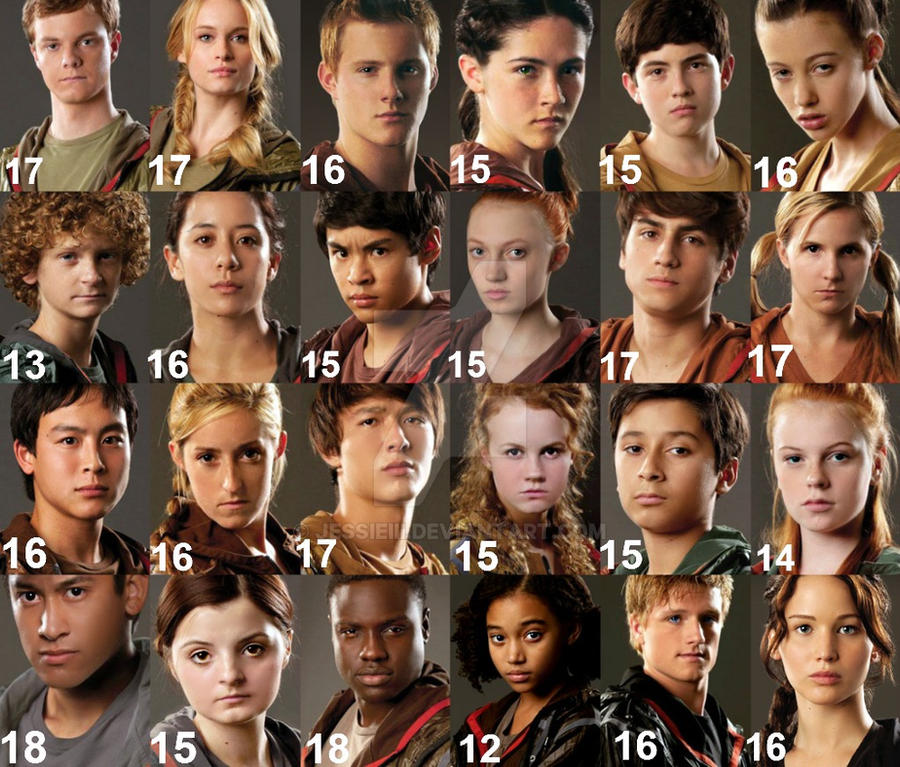District 1 Tributes: A Hunger Games Guide You Need!
Ever wondered what it takes to be a champion, a survivor, especially when thrust into a brutal arena? The Hunger Games' District 1 produced some of the most formidable, albeit often ruthless, competitors, and understanding their stories is key to grasping the Games' very essence.
Delving into the world of Panem and its districts reveals a complex tapestry of social stratification, resource allocation, and ultimately, survival. District 1, known for its luxury goods, stands in stark contrast to the impoverished District 12. This affluence translates into advantages for its tributes, who are often trained from a young age to compete in the Hunger Games. These "Career Tributes," as they are known, possess a skill set and mentality far exceeding that of their counterparts from poorer districts. They are often stronger, more skilled in combat, and psychologically prepared for the arena's challenges. Their participation is a calculated strategy, a demonstration of District 1's power and influence within the Capitol.
The concept of "Career Tributes" highlights the deeply ingrained inequalities within Panem. While tributes from other districts are thrust into the arena with little preparation, those from District 1 have dedicated their lives to this moment. This training encompasses physical conditioning, weapons mastery, and survival tactics. They understand the importance of alliances, strategic positioning, and psychological warfare. Their advantage is not merely physical; it's a result of systemic advantages afforded to them by their district's wealth and status. This disparity underscores the cruelty of the Hunger Games, a spectacle designed to entertain the Capitol elite while simultaneously punishing and controlling the districts.
- Meet Courtney Taylor Olsen Facts About The Olsen Familys Hidden Sister
- Taurus Scorpio Friendship Compatibility Challenges More
The 74th Hunger Games, a pivotal event in the trilogy, showcased the strengths and weaknesses of Career Tributes. While they often possessed superior combat skills, their overconfidence and lack of survival skills in unfamiliar environments could prove to be their downfall. The alliance between tributes from different Career districts was often fragile, based on strategic necessity rather than genuine camaraderie. This inherent tension frequently led to betrayal and infighting, ultimately weakening their collective power. The 74th Games, in particular, demonstrated that brute strength and strategic training were not always enough to guarantee victory; adaptability, resourcefulness, and the ability to form unexpected alliances could prove to be equally, if not more, valuable.
The 75th Hunger Games, also known as the Quarter Quell, presented a unique set of challenges that tested the mettle of even the most seasoned tributes. Gloss and Cashmere, the tributes from District 1, were experienced and formidable competitors. They were part of a carefully orchestrated plan to eliminate the rebellion's key figures. The Quarter Quell's twist, which involved tributes being reaped from the existing pool of victors, added a layer of complexity and resentment to the Games. The alliances shifted, and the stakes were higher than ever before. The fate of Panem rested on the outcome of these Games, and the tributes from District 1 played a crucial role in the unfolding drama.
The motivations of tributes from District 1 are often complex and multifaceted. While they are undoubtedly influenced by the Career Tribute system, they also possess their own individual desires and ambitions. Some may genuinely believe in the Capitol's ideology, while others may simply be seeking glory and recognition. The Hunger Games offer them an opportunity to escape the confines of their district and achieve a level of fame and fortune that would otherwise be unattainable. However, this pursuit of success comes at a tremendous cost, requiring them to sacrifice their humanity and engage in brutal acts of violence. The psychological toll of the Games is immense, leaving lasting scars on those who survive.
- Bumpy Johnson The Real Story Behind Harlems Godfather
- Khabib Nurmagomedovs Wife All About Patimat 2024 Update
Exploring the tributes from District 1 provides a window into the inner workings of Panem's social and political system. Their stories reveal the complex interplay of power, privilege, and survival in a world where the odds are stacked against the majority. By understanding their motivations, their strengths, and their weaknesses, we can gain a deeper appreciation for the themes of inequality, oppression, and rebellion that lie at the heart of the Hunger Games narrative.
The following table provides biographical and professional information, as well as career details, about notable tributes from District 1, offering a deeper understanding of their backgrounds and experiences within the Hunger Games universe.
| Tribute Name | District | Games | Age | Description | Career Tribute | Fate | Reference |
|---|---|---|---|---|---|---|---|
| Marvel Sanford | 1 | 74th Hunger Games | 16 | Strong and ruthless, but overconfident. Known for his skill with spears. | Yes | Killed by Katniss Everdeen after killing Rue. | The Hunger Games Wiki - Marvel |
| Glimmer Belcourt | 1 | 74th Hunger Games | 17 | Attractive and vain, but ultimately not very skilled. Relied heavily on her alliance. | Yes | Killed by tracker jacker stings during Katniss's attack on the Career's food supply. | The Hunger Games Wiki - Glimmer |
| Gloss | 1 | 75th Hunger Games (2nd Quarter Quell) | 27 (estimated) | A previous victor, skilled and strategic. | Yes | Killed by Katniss Everdeen. | The Hunger Games Wiki - Gloss |
| Cashmere | 1 | 75th Hunger Games (2nd Quarter Quell) | 26 (estimated) | A previous victor, known for her beauty and cunning. | Yes | Killed by Johanna Mason. | The Hunger Games Wiki - Cashmere |
These characters, products of a system designed for spectacle and control, reflect the complex moral landscape of Panem. Their stories are not just about survival, but also about the choices they make in the face of overwhelming pressure. Whether they are motivated by ambition, loyalty, or fear, the tributes from District 1 contribute to the rich and compelling narrative of the Hunger Games.
The Hunger Games, occurring annually, were a stark reminder of the Capitol's dominance over the twelve districts. The tributes, selected through a lottery system, were forced to fight to the death in a televised spectacle. This event served not only as entertainment for the Capitol citizens but also as a means of control and punishment for past rebellions. The reaping ceremony, where the tributes were chosen, was a moment of intense fear and uncertainty for the districts, highlighting the ever-present threat of the Capitol's power.
The arena itself was a carefully constructed environment, designed to test the tributes' skills and resourcefulness. The Gamemakers, led by figures like Seneca Crane in the 74th Games, controlled the environment, introducing challenges and obstacles to keep the tributes on their toes. The arena could range from lush forests to arid deserts, each presenting its own unique set of dangers. The tributes had to adapt to these environments quickly if they hoped to survive. The arena was a symbol of the Capitol's power, a place where the tributes were stripped of their humanity and forced to fight for their lives.
Alliances played a crucial role in the Hunger Games, as tributes often formed partnerships to increase their chances of survival. These alliances could be based on shared district affiliation, mutual respect, or simply strategic necessity. However, alliances were often fragile and subject to betrayal, as the ultimate goal was individual survival. The tributes had to constantly assess the loyalty of their allies and be prepared to turn on them if necessary. The alliances were a reflection of the complex social dynamics within the arena, where trust was a rare and valuable commodity.
The role of mentors was also significant, as they provided guidance and support to the tributes before and during the Games. Mentors were often former victors, who had firsthand experience of the arena's challenges. They helped the tributes develop strategies, secure sponsors, and navigate the political landscape of the Capitol. The relationship between mentor and tribute could be complex, often involving a mixture of guidance, manipulation, and genuine concern. The mentors were a reminder that even within the brutal world of the Hunger Games, there were still opportunities for human connection.
District 1, specializing in luxury goods, occupied a privileged position within Panem's economy. This economic advantage translated into better resources and training for their tributes, giving them a significant edge in the Games. The tributes from District 1 often possessed superior weapons, clothing, and survival gear, thanks to the support of their district and sponsors. This disparity in resources highlighted the inequalities within Panem, where the wealthier districts enjoyed a distinct advantage over the poorer ones. The economic disparity was a key factor in the resentment and rebellion that ultimately led to the downfall of the Capitol.
The Hunger Games Wiki serves as a comprehensive resource for information on all aspects of the Hunger Games universe, including the tributes, districts, events, and characters. It is a valuable tool for fans seeking to deepen their understanding of the story and its themes. The Wiki provides detailed information on each tribute, including their background, skills, and fate in the Games. It also offers insights into the political and social dynamics of Panem, helping to contextualize the events of the Hunger Games. The Hunger Games Wiki is a testament to the enduring popularity of the series and its ability to spark discussion and analysis.
The promotional campaigns surrounding the Hunger Games were carefully orchestrated by the Capitol to generate excitement and maintain control. These campaigns often involved extravagant displays of wealth and entertainment, designed to distract the districts from their poverty and oppression. The tributes were transformed into celebrities, their stories and personalities carefully crafted to appeal to the Capitol audience. The promotional campaigns were a cynical manipulation of the tributes' lives, turning them into pawns in the Capitol's political game.
The consequences of the Hunger Games extended far beyond the arena, leaving lasting scars on the survivors and their communities. The tributes who returned home were often traumatized by their experiences, struggling to cope with the violence and loss they had witnessed. The Games also had a profound impact on the districts, creating a sense of fear and hopelessness. The memories of the fallen tributes served as a constant reminder of the Capitol's power and the consequences of rebellion. The long-term consequences of the Hunger Games contributed to the growing unrest and ultimately led to the revolution.
Lucy Gray Baird, mentored by Coriolanus Snow, offers a contrasting perspective on the Hunger Games. Her story reveals the early stages of the Games and the evolving role of mentors and tributes. The Games were initially a crude and disorganized event, lacking the sophistication and spectacle of later editions. Lucy Gray's participation in the Games marked a turning point, as she used her charisma and talent to captivate the audience and gain sponsors. Her relationship with Snow was complex and fraught with manipulation, ultimately shaping both of their destinies. Lucy Gray's story is a reminder that even in the darkest of times, there is still room for hope, creativity, and rebellion.
The tributes from District 12, Katniss Everdeen and Peeta Mellark, played a pivotal role in igniting the rebellion against the Capitol. Their acts of defiance in the arena, such as their shared victory in the 74th Games, inspired hope and resistance throughout Panem. Katniss's courage and determination made her a symbol of the rebellion, while Peeta's compassion and empathy helped to unite the districts. Together, they challenged the Capitol's authority and paved the way for a new era of freedom and equality. Their story is a testament to the power of ordinary people to effect extraordinary change.
The head Gamemakers, like Seneca Crane, were responsible for designing the arena and controlling the events of the Games. They were tasked with creating a spectacle that would entertain the Capitol audience while also punishing the districts. The Gamemakers possessed immense power, able to manipulate the environment, introduce challenges, and even influence the fate of the tributes. Their decisions were often controversial, raising ethical questions about the morality of the Games. The head Gamemakers were a symbol of the Capitol's absolute power and its willingness to exploit the lives of the tributes for entertainment.
The role of sponsors was crucial in the Hunger Games, as they provided resources and support to the tributes. Sponsors were wealthy citizens of the Capitol who were captivated by the Games and willing to donate money and supplies to their favorite tributes. These resources could include food, medicine, weapons, and even strategic advice. Securing sponsors was essential for survival in the arena, as it could provide a significant advantage over the other tributes. The sponsors were a reflection of the Capitol's decadent culture, where wealth and entertainment were valued above human life.
The character naming guide is a valuable resource for fans and writers seeking to create authentic and believable characters within the Hunger Games universe. The guide provides insights into the naming conventions of each district and offers suggestions for creating names that reflect the characters' backgrounds and personalities. The guide also helps to ensure consistency and avoid clichs, enhancing the overall quality of the storytelling. The character naming guide is a testament to the attention to detail that Suzanne Collins brought to the creation of the Hunger Games world.
The poisonous fog, a deadly weapon used in the arena, highlights the Capitol's willingness to use extreme measures to control the tributes. The fog was a terrifying and indiscriminate threat, capable of causing excruciating pain and death. Its use in the arena demonstrated the Capitol's callous disregard for human life and its determination to maintain its power at any cost. The poisonous fog was a symbol of the Capitol's cruelty and its willingness to inflict suffering on the districts.
The trains and hovercrafts, manufactured in District 6, played a crucial role in transporting the tributes and supplies to and from the arena. These vehicles were a symbol of the Capitol's technological superiority and its ability to control the flow of resources within Panem. The workers in District 6 were responsible for maintaining and operating these vehicles, highlighting the district's essential role in the Hunger Games infrastructure. The trains and hovercrafts were a constant reminder of the Capitol's power and its control over the districts.
In conclusion, the tributes from District 1, along with all the elements of the Hunger Games universe, contribute to a complex and compelling narrative that explores themes of inequality, oppression, and rebellion. Their stories serve as a reminder of the importance of empathy, courage, and resistance in the face of injustice.
- Adriana Limas Kids A Glimpse Into Her Family Life Updated
- Mr Miyagis Untold Story The Life Legacy Of Pat Morita

Image HG81 tributes.jpg The Hunger Games Wiki Fandom powered by Wikia

Image Tributes 1.png The Hunger Games Wiki

Hunger Games Tributes by jessieiii on DeviantArt